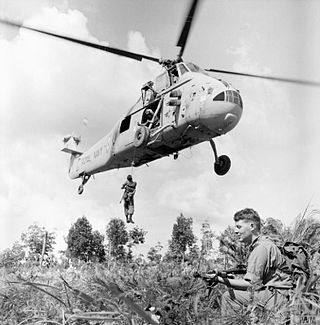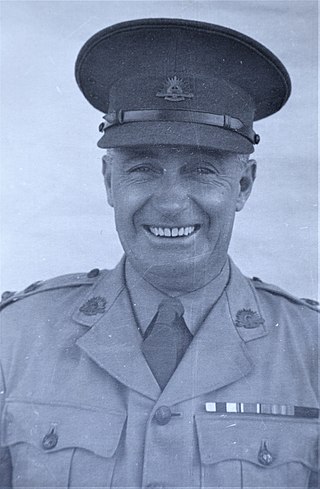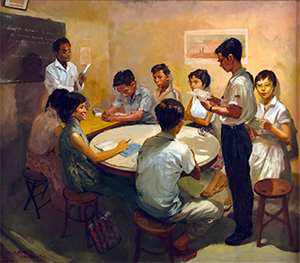
The Malayan Emergency, also known as the Anti–British National Liberation War, (1948–1960) was a guerrilla war fought in Malaya between communist pro-independence fighters of the Malayan National Liberation Army (MNLA) and the military forces of the Federation of Malaya and Commonwealth. The communists fought to win independence for Malaya from the British Empire and to establish a communist state, while the Malayan Federation and Commonwealth forces fought to combat communism and protect British economic and colonial interests. The term "Emergency" was used by the British to characterise the conflict in order to avoid referring to it as a war, because London-based insurers would not pay out in instances of civil wars.

The Indonesia–Malaysia confrontation or Borneo confrontation was an armed conflict from 1963 to 1966 that stemmed from Indonesia's opposition to the creation of the state of Malaysia from the Federation of Malaya. After Indonesian president Sukarno was deposed in 1966, the dispute ended peacefully.
A light horse field ambulance was an Australian World War I military unit whose purpose was to provide medical transport and aid to the wounded and sick soldiers of an Australian Light Horse brigade. Light horse field ambulance units served in the Australian Imperial Force (AIF) as part of the Australian Army Medical Corps.

Chin Peng, born Ong Boon Hua,

The Malayan Communist Party (MCP), officially the Communist Party of Malaya (CPM), was a Marxist–Leninist and anti-imperialist communist party which was active in British Malaya and later, the modern states of Malaysia and Singapore from 1930 to 1989. It was responsible for the creation of both the Malayan Peoples' Anti-Japanese Army and the Malayan National Liberation Army.
The history of the Australian Army is the culmination of the Australian Army's predecessors and its 120-year modern history. The Army has its origins in the British Army and colonial military forces of the Australian colonies that were formed prior to the Federation of Australia. These were gradually united into federal units between 1899 and 1903; thus forming the beginning of the Australian Army. The colonial forces were combined and formed the basis of the new army, when the Commonwealth of Australia was founded on 1 January 1901. The modern history of the Army began with its founding at the start of the 20th century as the colonial armies were officially united as the Commonwealth Military Forces. In 1916 the title 'Australian Military Forces' was adopted and remained its official name until 1980, after which it became known as the Australian Army.

The Senoi Praaq is a unit of the Royal Malaysia Police made up almost entirely of the tribal people of Peninsular Malaysia known as the Orang Asli (aborigines). The name Senoi Praaq means war people or those who fight in the Semai language. Roy Davis Linville Jumper considered them one of the finest jungle fighting forces and was highly successful in diminishing the threat by communist forces during the Malayan Emergency.

Operation Tiderace was the codename of the British plan to retake Singapore following the Japanese surrender in 1945. The liberation force was led by Lord Louis Mountbatten, Supreme Allied Commander of South East Asia Command. Tiderace was initiated in coordination with Operation Zipper, which involved the liberation of Malaya.
Counter-terrorism in Malaysia is a series of measures implemented in Malaysia to detect and prevent terrorism as well as to minimise damages from such terrorist acts should they occur. These measures involve all levels of security services including military, police, border and infrastructure security, civil defence, medical readiness and psychological preparedness. Malaysia also participates actively in international counter-terrorism efforts. The Internal Security Act 1960 (repealed 2012, replaced with Security Offences Act 2012 was enacted to prevent terrorism in Malaysia.
Australian involvement in the Malayan Emergency lasted 13 years, between 1950 and 1963, with army, air force and naval units serving. The Malayan Emergency was a guerrilla war fought between Commonwealth armed forces and the Malayan National Liberation Army (MNLA), the military arm of the Malayan Communist Party, from 1948 to 1960 in Malaya. The Malayan Emergency was the longest continuous military commitment in Australia's history. Thirty-nine Australians were killed and 27 wounded.

Southern Rhodesia, then a self-governing colony of the United Kingdom, sent two military units to fight with the Commonwealth armed forces in the Malayan Emergency of 1948–60, which pitted the Commonwealth against the Malayan National Liberation Army (MNLA), the military arm of the Malayan Communist Party. For two years, starting in March 1951, white Southern Rhodesian volunteers made up "C" Squadron of the Special Air Service (SAS). The Rhodesian African Rifles, in which black rank-and-filers and warrant officers were led by white officers, then served in Malaya from 1956 to 1958.

No. 90 (Composite) Wing was a Royal Australian Air Force (RAAF) wing that operated during the early years of the Malayan Emergency. Its purpose was to serve as an umbrella organisation for the RAAF units deployed in the conflict, No. 1 (Bomber) Squadron, flying Avro Lincolns, and No. 38 (Transport) Squadron, flying Douglas C-47 Dakotas. The wing was established in July 1950 and headquartered at Changi, on the east coast of Singapore. No. 1 Squadron operated from Tengah, in Singapore's west. No. 38 Squadron was based at Changi and, from April 1951 to February 1952, at Kuala Lumpur in central Malaya. The Lincolns generally conducted area bombing missions, as well as precision strikes, to harass communist insurgents. The Dakotas were tasked with airlifting cargo, VIPs, troops and casualties, as well as courier flights and supply drops. Following No. 38 Squadron's departure in December 1952, No. 90 Wing was disbanded, leaving No. 1 Squadron to carry on as the sole RAAF unit in the Malayan air campaign until its withdrawal to Australia in July 1958.

The assassination of Sir Henry Gurney took place on 6 October 1951 at the height of the Malayan Emergency. Gurney, the British High Commissioner in Malaya, was killed by members of the Malayan Communist Party at Mile 56 ½ of Kuala Kubu Road on his way to Fraser's Hill for a meeting.

Operation Malaya is a 1953 British documentary about the actions of British troops during the Malayan Emergency.

Lutong is a suburban township in Miri, a city in the state of Sarawak in Malaysia. An oil refinery was built in Lutong by Shell Oil Company. Lutong's economy is generated mainly from staff of the oil and gas companies located nearby.

Brigadier William Charles Douglas Veale,, generally known as W. C. D. Veale, was an Australian engineer, surveyor and soldier. He is best known as the longtime (1947–1965) town clerk of the Adelaide City Council, and had significant influence in the development and change of character of the City of Adelaide during that period. For example, in conjunction with four-time Lord Mayor of Adelaide, Arthur Campbell Rymill, Veale was responsible for significant improvements to the Adelaide Park Lands. He was also a senior soldier and military engineer who served in both the First and Second World Wars, and is notable for his involvement in the Battle of Timor and during the Japanese occupation of the Dutch East Indies.
Operation Termite took place during the Malayan Emergency. It involved extensive attacks on communist camps, dropping over 200 British troops into the jungle. Communist casualties were low but many camps were destroyed.

Lieutenant Colonel John Charles Robertson was a senior officer in the Australian Army who served in both the First and Second World Wars.
The three branches of the Australian Defence Force are each represented by flags, among other emblems and insignia. Within each service, various symbols fly on individual ships, at bases, camps, the Australian Defence Force Academy and colleges. These include flags, standards, guidons and banners and that denote rank, appointment, corps, formations, regiments, training units and sub-units.

The Equator Art Society was an artists' group founded in 1956 in Singapore, known for promoting social realist art. The Equator Art Society sought to represent the realities and struggles of the masses, depicting Singapore's working classes and the poor often through the use of portraiture painting, woodcut prints, and sculpture. Founding society members and leaders included artists such as Lim Yew Kuan, Lai Kui Fang, Chua Mia Tee, Ong Kim Seng and Koeh Sia Yong.















